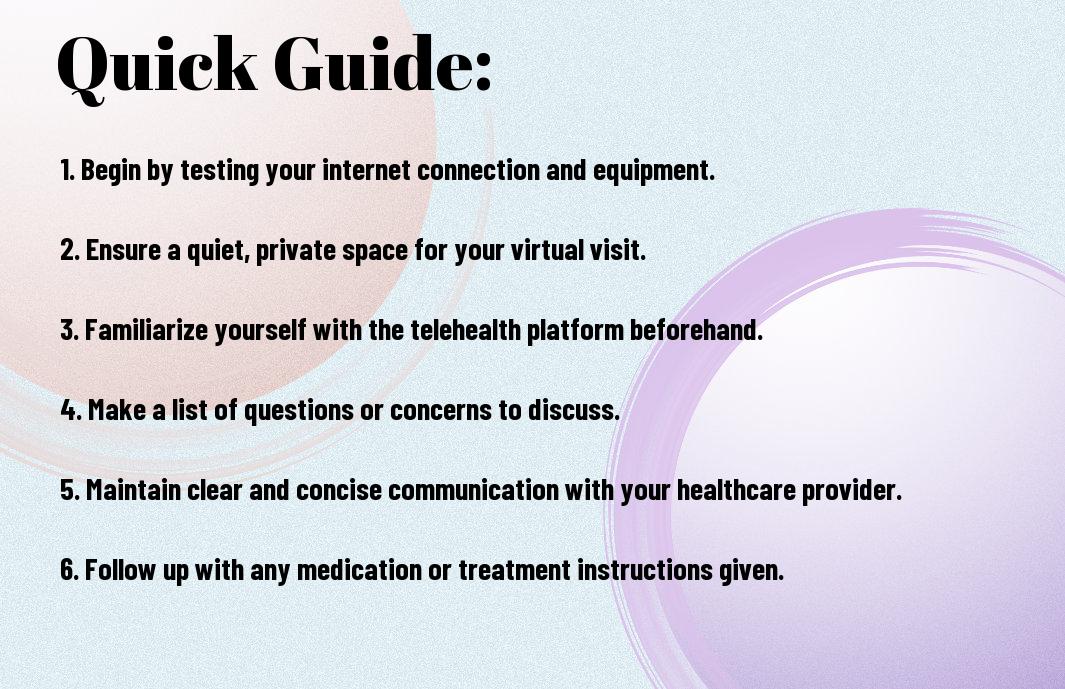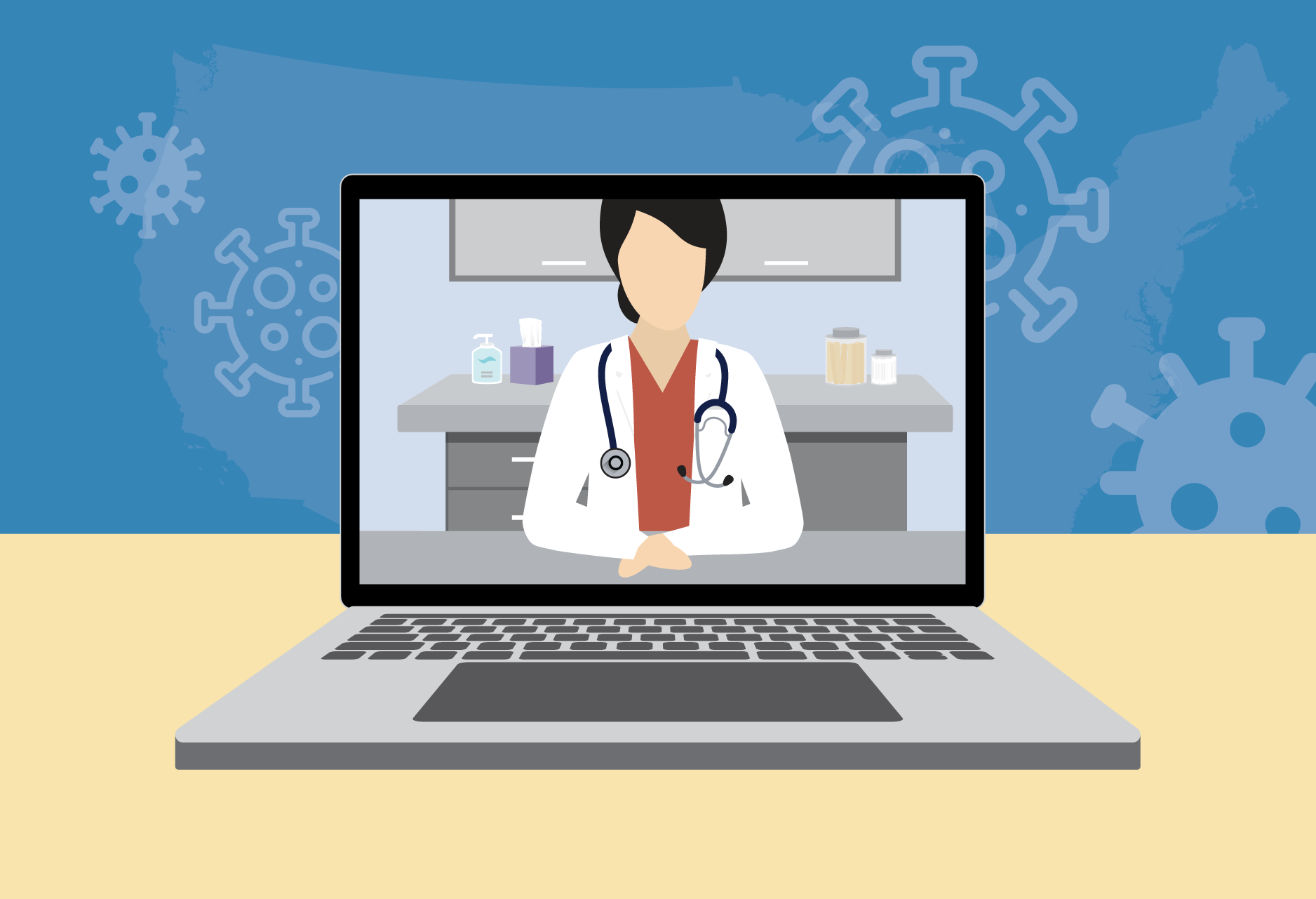Over the past year, telehealth has become an increasingly popular and convenient way to access medical care.
Whether you’re a seasoned pro or new to the world of virtual visits, there are key strategies you can employ to ensure that your telehealth experiences are as seamless and beneficial as possible.
In this guide, we’ll provide you with practical tips on how to prepare for your virtual visit, navigate the technological aspects with ease, and effectively communicate with your healthcare provider.
By following these guidelines, you can optimize your telehealth appointments and receive quality care from the comfort of your own home.
Key Takeaways:
- Prepare for Your Visit: Set up a quiet, well-lit space with a stable internet connection, and have any necessary medical information or questions ready.
- Smooth Technological Experience: Familiarize yourself with the telehealth platform beforehand, test your device’s camera and microphone, and ensure any required apps or software are up to date.
- Effective Communication: Speak clearly, ask questions, and openly discuss your concerns with your healthcare provider during the virtual visit to ensure a thorough and accurate assessment.
- Maximize Benefits: Take advantage of the convenience and accessibility telehealth offers by actively participating in your care and engaging with your healthcare team as you would in an in-person appointment.
- Quality Care From Home: Embrace the comfort and convenience of receiving healthcare services from your own home while still receiving the same level of quality care as you would in a traditional setting.
Understanding Telehealth
It is important to have a clear understanding of telehealth before delving into its benefits.
Telehealth refers to the use of digital communication technologies to access healthcare services remotely.
This can include virtual visits with healthcare providers, remote monitoring of medical conditions, and even online consultations with specialists.
Understanding the different types of telehealth services available can help you make the most of this convenient healthcare option.
Definition and Types of Telehealth Services
Now, let’s break down the definition and types of telehealth services. Telehealth encompasses a variety of services, including live video consultations, remote monitoring of vital signs, and secure messaging with healthcare providers.
Any individual with access to a smartphone, tablet, or computer with internet connection can benefit from telehealth services.
Evolution and Current Trends in Telehealth
Services in telehealth have evolved significantly over the years and continue to adapt to meet the changing needs of patients and healthcare providers.
It allows for increased access to healthcare services, especially in remote or underserved areas. It also enables patients to receive medical care from the comfort of their own homes, reducing the need for in-person visits.
This flexibility has become even more crucial in light of the COVID-19 pandemic, where telehealth has emerged as a safe and effective way to receive healthcare services.
Preparing for Your Telehealth Appointment
Some key aspects to consider before your telehealth appointment include ensuring you have the necessary equipment and technology, as well as creating a suitable environment for the virtual visit.
Equipment and Technology Checklist
Even before your telehealth appointment, make sure you have a reliable internet connection, a device with a camera and microphone (such as a smartphone, tablet, or computer), and a quiet space where you can focus on your appointment without distractions.
It’s also a good idea to test your audio and video settings beforehand to ensure everything is working properly.
Creating a Suitable Environment
Creating a suitable environment for your telehealth appointment is crucial for a successful virtual visit.
Find a quiet and well-lit area in your home where you can sit comfortably and have a stable internet connection.
Minimize background noise and distractions to ensure clear communication with your healthcare provider.
Equipment and technology play a crucial role in the success of your telehealth appointment.
Having the right tools and a conducive environment can help facilitate effective communication and ensure a seamless virtual visit.
Tips for a Successful Virtual Visit
Many individuals may be new to the concept of telehealth, but with proper preparation, it can be a seamless experience.
Testing your technology beforehand is vital to ensure a smooth virtual visit.
Make sure your internet connection is stable, your device’s camera and microphone are functioning properly, and that you are familiar with the platform your healthcare provider will be using.
By conducting a trial run before your appointment, you can address any technical issues beforehand and ensure a successful virtual visit.
Testing Your Technology Beforehand
Virtual visits rely heavily on technology, so it’s important to ensure everything is working correctly beforehand.
Take the time to test your internet connection, camera, and microphone to avoid any disruptions during your appointment.
- Test your internet connection to ensure it is strong and stable.
- Check that your device’s camera and microphone are working properly.
Perceiving any technological issues ahead of time will help you address them before your virtual visit, allowing you to fully engage with your healthcare provider without interruptions.
Communicating Effectively with Your Provider
Virtual visits offer convenience and comfort, but effective communication with your healthcare provider is vital for a successful telehealth experience.
Establishing clear communication channels and actively participating in the conversation can help ensure that your healthcare needs are met effectively.
Communicating your symptoms, concerns, and questions clearly and concisely will help your healthcare provider understand your situation and provide appropriate care recommendations.
Additionally, don’t hesitate to ask for clarification or further information if needed during your virtual visit.
Step-by-Step Guide to Accessing Telehealth
To ensure a smooth telehealth experience, it is vital to follow a step-by-step guide on accessing telehealth.
Below is a breakdown of the process into two key sections: Scheduling Your Virtual Appointment and Steps to Follow on the Day of Your Telehealth Session.
Scheduling Your Virtual Appointment
If you are new to telehealth or using a new platform, start by contacting your healthcare provider’s office to schedule your virtual appointment.
Make sure to provide them with all the necessary information, such as your email address and preferred method of communication. It is also important to confirm the date and time of your appointment, ensuring that you are available and have set aside enough time for the session.
Steps to Follow on the Day of Your Telehealth Session
Any technology-related issues can disrupt your telehealth session, so it is crucial to follow these steps on the day of your appointment.
Ensure that your device, whether it’s a computer, tablet, or smartphone, is fully charged and connected to a stable internet connection.
Familiarize yourself with the telehealth platform you will be using, and test the audio and video settings beforehand to avoid any technical difficulties during the session.
Your healthcare provider may also require you to fill out any necessary forms or provide specific information before the appointment.
Be prepared to answer any questions about your medical history or current symptoms to help your provider better assess your health needs during the telehealth session.
By following these steps, you can make the most of your telehealth experience and receive quality care from the comfort of your home.
Factors to Consider When Using Telehealth
For a successful telehealth experience, there are several factors to consider in order to make the most of your virtual visit.
By taking these aspects into account, you can ensure a smooth and effective healthcare appointment from the comfort of your own home.
Choosing the Right Provider
On your telehealth journey, selecting the right healthcare provider is crucial to receiving quality care.
Make sure to choose a provider who is experienced in telemedicine and has a track record of successful virtual consultations.
The ability to effectively communicate and address your healthcare needs remotely is necessary for a positive telehealth experience.
Additionally, consider the provider’s reputation, reviews, and any specific qualifications they may have in telehealth.
Insurance and Cost Considerations
Provider reimbursement for telehealth services has been expanding, with many insurance companies covering these virtual visits.
When considering telehealth, it is important to check with your insurance provider to understand your coverage and any potential out-of-pocket costs.
The convenience of telehealth can extend to cost savings for patients, as it eliminates the need for travel expenses and time off work for in-person appointments.
The ability to receive quality care from the comfort of your own home can be a cost-effective option for many individuals.
Cost should not be a barrier to accessing telehealth services, and many providers offer flexible payment options or sliding-scale fees for uninsured patients.
Be sure to inquire about any potential costs upfront to ensure a seamless and worry-free telehealth experience.
The Pros and Cons of Telehealth
All pros and cons of telehealth can be examined to determine whether this healthcare advancement is right for you. Below is a breakdown of the advantages and potential drawbacks of telehealth services:
| Advantages | Potential Drawbacks |
|---|---|
| Convenience | Possible technical issues |
| Cost-effective | Lack of in-person physical examination |
| Time-saving | Privacy concerns |
Advantages of Telehealth Services
The benefits of telehealth services cannot be understated. The convenience, cost-effectiveness, and time-saving aspects make it an attractive option for many individuals.
With telehealth, you can receive quality care without having to leave the comfort of your own home.
This is especially beneficial for those with mobility issues or those who live in remote areas where healthcare access is limited.
Potential Drawbacks and How to Address Them
Some potential drawbacks of telehealth include possible technical issues during virtual visits, the lack of in-person physical examination, and privacy concerns related to sharing personal health information online.
However, these drawbacks can be addressed by ensuring a smooth technological experience, effectively communicating with your healthcare provider, and utilizing secure telehealth platforms.
By taking proactive steps to address these concerns, you can still receive quality care through telehealth with peace of mind.

To wrap up
With these considerations in mind, you are well on your way to making the most of telehealth and optimizing your healthcare experience.
By taking the time to prepare for your virtual visit, ensure a smooth technological experience, and effectively communicate with your healthcare provider, you can receive quality care from the comfort of your own home.
Remember that telehealth offers convenience, accessibility, and flexibility, so don’t hesitate to utilize this valuable tool for your healthcare needs.
Following the guidelines provided in this guide, you can maximize the benefits of telehealth and make your virtual visits as effective and efficient as possible.
Here’s to your health and well-being, and may your telehealth experiences be seamless and beneficial!
FAQ
Q: What is telehealth?
A: Telehealth is the use of digital information and communication technologies, such as computers and mobile devices, to access healthcare services remotely and manage your health care.
Q: How can I prepare for a virtual visit with my healthcare provider?
A: To prepare for your virtual visit, ensure you have a stable internet connection, find a quiet and private space for the appointment, have your medical history and current medications ready, and familiarize yourself with the telehealth platform being used.
Q: What should I do to ensure a smooth technological experience during my telehealth appointment?
A: To ensure a smooth technological experience, test your audio and video settings beforehand, ensure your device is fully charged or plugged in, close unnecessary applications or tabs, and consider using headphones for clearer audio.
Q: How can I effectively communicate with my healthcare provider during a telehealth appointment?
A: To effectively communicate with your healthcare provider, speak clearly and concisely, ask questions about your health concerns or treatment plan, actively participate in the conversation, and be honest about your symptoms or concerns.
Q: What are the benefits of using telehealth for receiving healthcare services?
A: The benefits of telehealth include convenience of receiving care from home, reduced travel time and expenses, increased access to specialists and healthcare providers, and the ability to maintain continuity of care without leaving your house.

